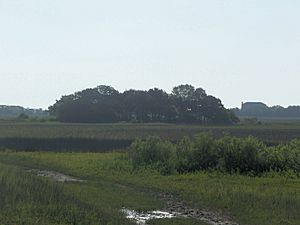Siege of Fort Mose facts for kids
Quick facts for kids Battle of Fort Mose |
|||||||
|---|---|---|---|---|---|---|---|
| Part of the War of Jenkins' Ear | |||||||
 Site of the old fort |
|||||||
|
|||||||
| Belligerents | |||||||
| Commanders and leaders | |||||||
| Col. John Palmer † | Cap. Antonio Salgado Francisco Menéndez |
||||||
| Strength | |||||||
| 170 regulars and Indians | 300 regulars some militia Indian auxiliaries free black auxiliaries |
||||||
| Casualties and losses | |||||||
| 68–75 killed 34 captured |
10 killed 20 wounded |
||||||
The Battle of Fort Mose, also known as Bloody Mose, was an important fight during the War of Jenkins' Ear. It happened on June 14, 1740, in Spanish Florida. Spanish forces, led by Captain Antonio Salgado, attacked Fort Mose. They were joined by a free black militia, led by Francisco Menéndez, and Seminole warriors.
The fort was held by 170 British soldiers under Colonel John Palmer. The British had taken Fort Mose from the Spanish earlier. This was part of James Oglethorpe's plan to capture St. Augustine. The British were surprised by the attack. Many were killed, including Colonel Palmer. The battle destroyed the fort. The Spanish did not rebuild it until 1752.
Contents
What Was Fort Mose?
Fort Mose was built in 1738 by the Spanish. It was located two miles north of St. Augustine. This fort was a safe place for people escaping slavery from the British colonies of Georgia and South Carolina.
About 45 years before, in 1693, King Charles II of Spain made a rule. He said that any person escaping slavery from the Virginia Colony would be free in Florida. They just had to become Catholic and agree to serve Spain.
Life at Fort Mose
The fort had a church, a wooden wall with towers, and about 20 houses. Around 100 people lived there. These free people were made part of the Spanish militia. Governor Manuel de Montiano put them under the command of Captain Francisco Menéndez. He was a leader who had escaped slavery from South Carolina.
Fort Mose was important to the Spanish for two reasons. It was a community for free people. It also served as a front-line defense for Spanish Florida. It protected against attacks from the British colonies. News of this free community reached South Carolina. It is thought to have inspired some people to seek freedom in Spanish Florida.
The War Begins
The War of Jenkins' Ear started in 1739. General James Oglethorpe, who was the governor of Georgia, decided to attack St. Augustine. He wanted to capture the capital of Spanish Florida. As part of his plan, Oglethorpe knew his forces needed to take Fort Mose.
Oglethorpe gathered his army. It included soldiers from South Carolina and Georgia. There were also militia volunteers and about 600 Creek and Uchise allies. About 800 black auxiliaries also joined. Seven ships from the Royal Navy supported them from the sea.
The Spanish governor, Montiano, had about 600 soldiers. He also had new troops from Cuba. He began to dig trenches to defend his position. He tried to surprise the British lines several times, but he was not successful.
The Battle at Fort Mose
As the British got closer to St. Augustine, a group led by Colonel John Palmer took Fort Mose. This group had 170 men. They were from the Georgia militia, the Highland Independent Company, and native allies. Fort Mose was in a very important spot for travel.
The British forces had problems with their leaders. The Highlanders spoke mostly Gaelic. They did not think Colonel Palmer was a good leader. Colonel Palmer also did not trust the Highlanders' skills as disciplined soldiers.
Governor Montiano had ordered the fort to be left empty earlier. Some of its residents had been killed by British-allied native groups. The free black residents had moved to St. Augustine for safety.
While Oglethorpe's army was attacking St. Augustine, Montiano thought about what to do. He knew how important Fort Mose was. He also saw that it was not well-defended by the British. So, Montiano decided to launch a surprise attack to take it back.
The Surprise Attack
At dawn on June 14, Captain Antonio Salgado led Spanish soldiers. Francisco Menéndez led the free black militia and Seminole Indian allies. They launched a surprise attack on Fort Mose. The attack started two hours before the British soldiers woke up. This meant the British could not get their weapons ready to fight.
The fighting was fierce and close-up. Soldiers fought with swords, muskets, and clubs. About 75 British troops were killed. Another 34 were captured.
After the Battle
The Spanish victory at Fort Mose greatly hurt the British forces. They were already having disagreements among themselves. This loss was a big reason why Oglethorpe decided to go back to Savannah. In late June, Spanish forces from Havana arrived to help St. Augustine. The Royal Navy ships then left the land forces.
Governor Montiano praised the free black militia for their bravery. Fort Mose had been destroyed in the battle. But its former residents lived in St. Augustine for the next ten years. They were free and equal Spanish citizens.
The Spanish rebuilt Fort Mose in 1752. The free black residents returned to live there. Later, after the British won the Seven Years' War, they took control of East Florida. Most of the residents and soldiers from Fort Mose moved to Cuba. Francisco Menéndez and most of the free black community went with them.
Images for kids
See also
 In Spanish: Asalto al Fuerte Mosé para niños
In Spanish: Asalto al Fuerte Mosé para niños


